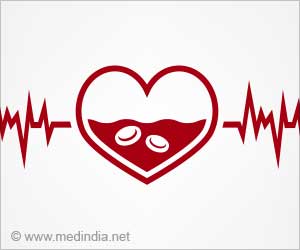Healthy amounts of red blood cells are necessary for the supply of oxygen to all the body tissues. Iron is one of the
and is thereby required for hemoglobin production in the RBCs. Iron deficiency
like hospitalizations and death. Moreover, a FAIR-HF trial2 showed that the functional capacity, symptoms, and quality of life were improved in heart failure patients with intravenous treatment of iron.
This allowed further exploration of the FAIR-HF 2 trial in exploring the effect of intravenous iron supplementation on the mortality rates of heart failure. The present study thus examined the link between iron deficiency and outcomes in the general population.
“This was an observational study and we cannot conclude that iron deficiency causes heart disease. However, evidence is growing that there is a link and these findings provide the basis for further research to confirm the results,” says study author Dr. Benedikt Schrage of the University Heart and Vasculature Centre Hamburg, Germany.
The Analyzation Done
The study team incorporated three European population-based cohorts with 12,164 participants (55% were women) with a median age of 59 years.
The blood samples were clinically used to assess the comorbidities like diabetes, obesity smoking, cholesterol, and other cardiovascular risk factors during the baseline study visit. The classification of the participants was done based on their presence or absence of iron deficiency as per the following definitions:
-
Absolute iron deficiency – refers to a condition that includes only stored iron (ferritin). - Functional iron deficiency – refers to a condition that includes iron in storage (ferritin) and iron in circulation for use by the body (transferrin).
“Absolute iron deficiency is the traditional way of assessing iron status but it misses circulating iron. The functional definition is more accurate as it includes both measures and picks up those with sufficient stores but not enough in circulation for the body to work properly”, says Dr. Schrage.
Incidence of Cardiovascular Diseases
The incidence and mortality rate of cardiovascular diseases like coronary heart disease, stroke, and other causes were observed during the follow-up of participants.
The correlation of CAD and iron deficiency was done with different age groups, body mass index, sex, diabetes, cholesterol, smoking, blood pressure, and inflammation. Among the baseline, almost 64% had functional iron deficiency and 60% of participants had absolute iron deficiency.
The follow-up period was for a median of 13.3 years. During the time, 2,212 (18.2%) deaths were encountered that comprised 573 deaths (4.7%) from a cardiovascular cause.
The incidence of coronary heart disease and stroke was identified in 1,033 (8.5%) and 766 (6.3%) participants, respectively.
The Link between Iron Deficiency & Heart Disease
Almost 24% higher risk of coronary heart disease was observed in functional iron deficiency. Moreover, the risk of cardiovascular mortality was raised by 26%, and the risk of mortality from all-cause increased up to 12% when compared to the absence of functional iron deficiency.
When observed in terms of absolute iron deficiency, an almost 20% elevated risk of coronary heart disease was seen as compared to no absolute iron deficiency. However, absolute iron deficiency revealed no link with mortality rates and stroke incidence.
The team also calculated the estimates of the event proportion in 10 years. It was found that 11.7% of cardiovascular deaths, 5.4% of all deaths, and 10.7% of new coronary heart disease diagnoses were confined to functional iron deficiency within 10 years.
What to Derive?
The study data thereby suggests that the absence of baseline iron deficiency may prevent almost 12% of cardiovascular deaths, 5% of overall deaths, and 11% of new coronary heart disease diagnoses in the succeeding decade.
Moreover, the high prevalence of functional iron deficiency was almost two-third in the middle-aged population and the next 13 years; these individuals were likely to develop heart disease.
Following this significant finding, the team anticipates further studies in younger and non-European cohorts to establish necessary treatment strategies to overcome treating iron deficiency in the general population.
Facts on Heart attack and Stroke
-
Heart diseases are the leading cause of death for most people in the United States. -
One in every six deaths from cardiovascular disease was due to stroke in 2018. -
Heart attacks are silent (the person is not aware of it) in every 1 in 5 individuals. -
Stroke is a leading cause of long-term disability especially among seniors globally. -
Every 40 seconds someone has a stroke and heart attack and every 4 minutes, someone dies of a stroke in the United States.
Facts on Iron
-
Iron is also called a workhorse nutrient. -
It is estimated that almost 20% of women (during their menstrual stage) in North America have iron deficiency. -
Almost 2 billion people worldwide are anemic among which >1 billion suffer from iron deficiency anemia. -
A study suggests that obese people may have poor absorption of iron. -
Appearing pale and feeling fainted is among the most common signs of iron deficiency. However, they are not the only ones. -
Iron deficiency symptoms may be vague and range from headache, dizziness, brittle nails, irritability, to shortness of breath, and irregular heartbeat. -
Potent iron-rich diets may easily help prevent iron deficiency. -
The recommended amount of iron is 8.7mg/day for men and 14.8mg/day for women. - Intake of very high iron doses can be even fatal; Hence, it is important to consult your doctor before taking the iron supplements
References:
- Ferric carboxymaltose in patients with heart failure and iron deficiency
– (https://pubmed.ncbi.nlm.nih.gov/19920054/) - Association of anaemia and all-cause mortality in patients with ischaemic heart failure varies by renal function status
– (https://pubmed.ncbi.nlm.nih.gov/33838020/) - Stroke Facts
– (https://www.cdc.gov/stroke/facts.htm) - Iron deficiency anemia – (https://www.mayoclinic.org/diseases-conditions/iron-deficiency-anemia/symptoms-causes/syc-20355034)
- Iron – (https://www.nhs.uk/conditions/vitamins-and-minerals/iron/)
Source: Medindia



